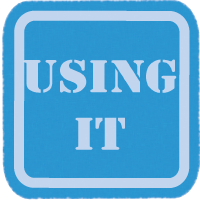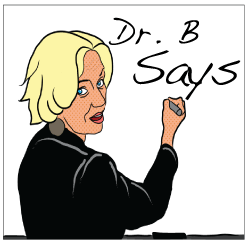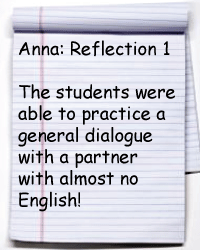
 Oral interaction: Dialogue vs. Conversations
Oral interaction: Dialogue vs. Conversations
As Anna observes in future reflections, having students simply recite a scripted dialogue is not a complete approach to helping them practice the language. For a teacher unaware of the difference between the above-mentioned types of speaking activities, having students recite dialogues might seem like an effective activity that will help students improve their language abilities. However, a more hands-on and student centred approach yields more substantial and positive results. |
back to case study |
What is the difference between scripted dialogue, partially scripted dialogue and conversation?
Each of these approaches yield different results in terms of what the student is able to produce: are they able to read a scripted text accurately? Are they able to fill in gaps in a partially scripted text? Are they able to use their knowledge of the language to spontaneously engage in a conversation?
The table below summarizes the characteristics of each type of speaking activity, and what can be expected as a result of using each type.
Type of speech |
Characteristics |
Expected Outcome |
Scripted Dialogue |
Between two or more students; each student has a completely scripted portion of the dialogue to read and no additions to the dialogue are expected. |
The students gain more comfort with their ability to say the vocabulary found in the dialogue; they are able to experiment with pronunciation and may gain confidence in their ability to talk in the language classroom. |
Partially Scripted Dialogue |
Between two or more students; one student may have a scripted portion of the dialogue to read (i.e. questions) and the other student(s) must spontaneously develop and say their section of the dialogue (i.e. answers). To be effective, students must take turns being the student with the scripted section of the dialogue. |
While reading the scripted section of the dialogue, the student can work on pronunciation and building confidence with the language. While creating the spontaneous portion of the dialogue, students gain valuable practice transferring vocabulary and grammar concepts, and using their language awareness to suit the context of the dialogue. |
Conversation |
Between two or more students; the students are given a topic to discuss, and engage in spontaneous conversation related to the topic. There is no script to use; students must develop the conversation entirely on their own. |
All of the students are able to transfer concepts and vocabulary learned in a different context to a new context, thereby expanding their language range. Students will be able to develop more confidence in their abilities, knowing they are able to spontaneously create messages in the second language. |
back to top
 |
Watch the video and decide if these students are practicing a dialogue, a partially scripted dialogue or a conversation. Explain your answer. Do you think that the task the students perform has helped them to learn the language? |
What other activities and strategies can I use to get students talking?
There are a variety of ways to get your students to speak in the language classroom and even more activities that make use of these different approaches. Scripted dialogue, partially scripted dialogue and conversation are just three ways to get students to practice oral interaction. For more ideas and information about oral interaction click here.

“Oral Language and the Second Language Learner. ERIC Research Summary.” http://www.eric.ed.gov/ERICDocs/data/ericdocs2sql/content_storage_01/0000019b/80/1b/8c/a2.pdf


 Anna observed her mentor teacher using a scripted dialogue with her students. She saw that, with this method, her students were able to recite the dialogue well and were engaged. Even if the students were engaged, were they actively practicing their language skills?
Anna observed her mentor teacher using a scripted dialogue with her students. She saw that, with this method, her students were able to recite the dialogue well and were engaged. Even if the students were engaged, were they actively practicing their language skills?
